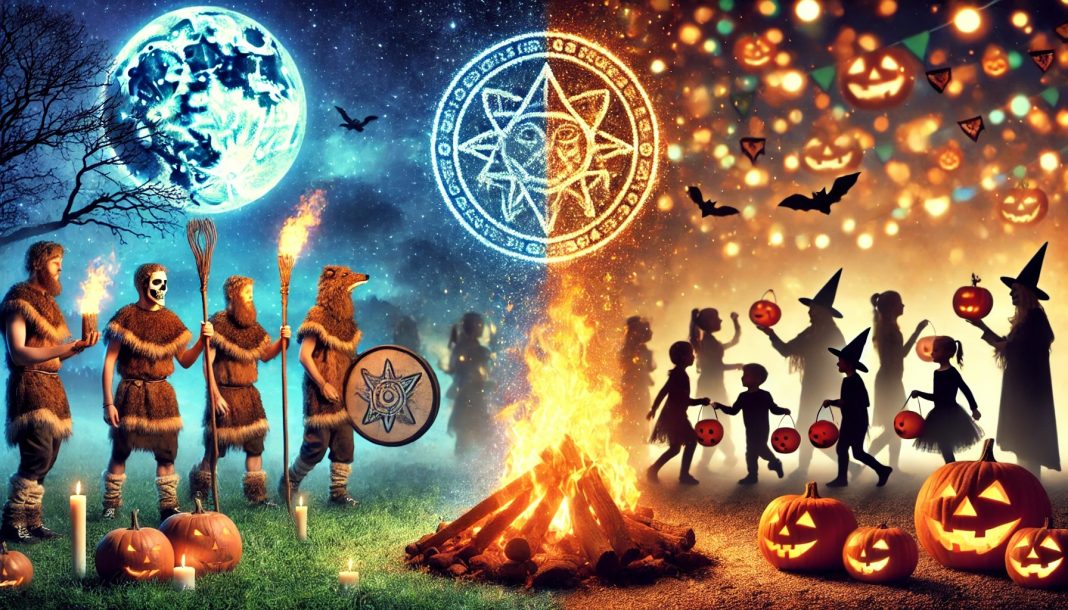In a couple of days kids are going to fill your streets and knock on your doors. What for? CANDY WHAT ELSE!! (Fair warning: I might be hiding in the crowd for free sweets). But Halloween’s upcoming presence might make you think about its origin. Where did Halloween come from and how did it go from religious ritual to a commercial success of 12.2 billion dollars in 2023?
Hello October! 🎃🍁🔥 pic.twitter.com/cegNhpAJaX
— Halloween Countdown (@HalloweenCounts) October 1, 2024
Centuries ago, October 31st wasn’t about candy or costumes. It was a night when spirits roamed the earth, marking the origins of Halloween. That night, the Celts celebrated Samhain (pronounced “Sow-in”), believing the veil between the living and the dead was thinnest. Over time, Christianity reshaped these ancient traditions, transforming Samhain into what we know as Halloween. This evolution wasn’t immediate but reflects the blend of cultures and beliefs.
Read more about the origins of Halloween
Samhain: Honoring the Dead and Nature’s Cycles
Samhain, celebrated over 2,000 years ago by the Celts in regions like Ireland and Northern France, marked the end of the harvest and the beginning of winter. The season was linked to death, and on October 31st, the Celts believed the line between the world of the living and the dead blurred. Spirits, both benevolent and mischievous, were thought to cross into the world of the living.
People honored their ancestors, offering food and lighting bonfires to guide them. Costumes made from animal skins were worn to hide from wandering spirits, while rituals aimed to predict the future. The night symbolized the natural cycle of life, death, and rebirth—a powerful time for the Celtic people.
Learn more about Samhain’s Pagan Traditions
Christianity’s Influence: From Samhain to All Hallows’ Eve
When Christianity spread through Europe, it encountered strong pagan traditions. Instead of suppressing these festivals, the Church found a way to incorporate them. The solution? Co-opting local festivals, giving them new meanings, and aligning them with Christian beliefs.
In the 9th century, the Church declared November 1st as All Saints’ Day, or All Hallows’ Day. It was no coincidence that it was placed near Samhain. The night before, October 31st, became All Hallows’ Eve—eventually shortened to Halloween. This marked a crucial point in the origins of Halloween as the Church shifted attention from spirits to saints.
Yet, many Samhain traditions remained. Bonfires were still lit, and people continued to wear costumes. The interpretation of these rituals changed, but the essence survived.
Explore more about how Halloween evolved in Encyclopedia Britannica
A Secular Transformation
As the centuries passed, Halloween continued to evolve, especially in America. Irish and Scottish immigrants brought Halloween traditions with them in the 19th century. Carving turnips, which later became pumpkins, and playing pranks were common practices that caught on in the U.S.
By the early 20th century, Halloween had largely shed its religious meanings. Trick-or-treating emerged, evolving from the Celtic tradition of offering food to spirits and the Christian practice of “souling.” Children would go door-to-door offering prayers in exchange for treats. This eventually became the playful tradition of collecting candy.
Halloween became more about fun and less about faith or fear of spirits. The holiday transformed into a community celebration, distancing itself from its spiritual roots.
Halloween Today: Ancient Roots, Modern Fun
Though Halloween is now a light-hearted celebration, it still carries remnants of its ancient origins. Themes of death, spirits, and the supernatural linger, even if most people don’t realize the depth of their meaning. When we dress up in costumes, carve pumpkins, and light candles, we echo traditions that began with the Celts and were later reshaped by Christianity.
The journey from Samhain to Halloween is a testament to the resilience of cultural traditions. Even as the Church sought to transform the festival, elements of Samhain survived, blending into a new context. The origins of Halloween show that traditions can evolve yet still retain the essence of what they once represented.
As you celebrate Halloween, remember that beneath the surface lies a rich history. This is a night that connects us to the past, when people believed the dead walked among the living. Whether seen as a pagan festival or simply a night for fun, Halloween’s roots run deep in ancient traditions.














